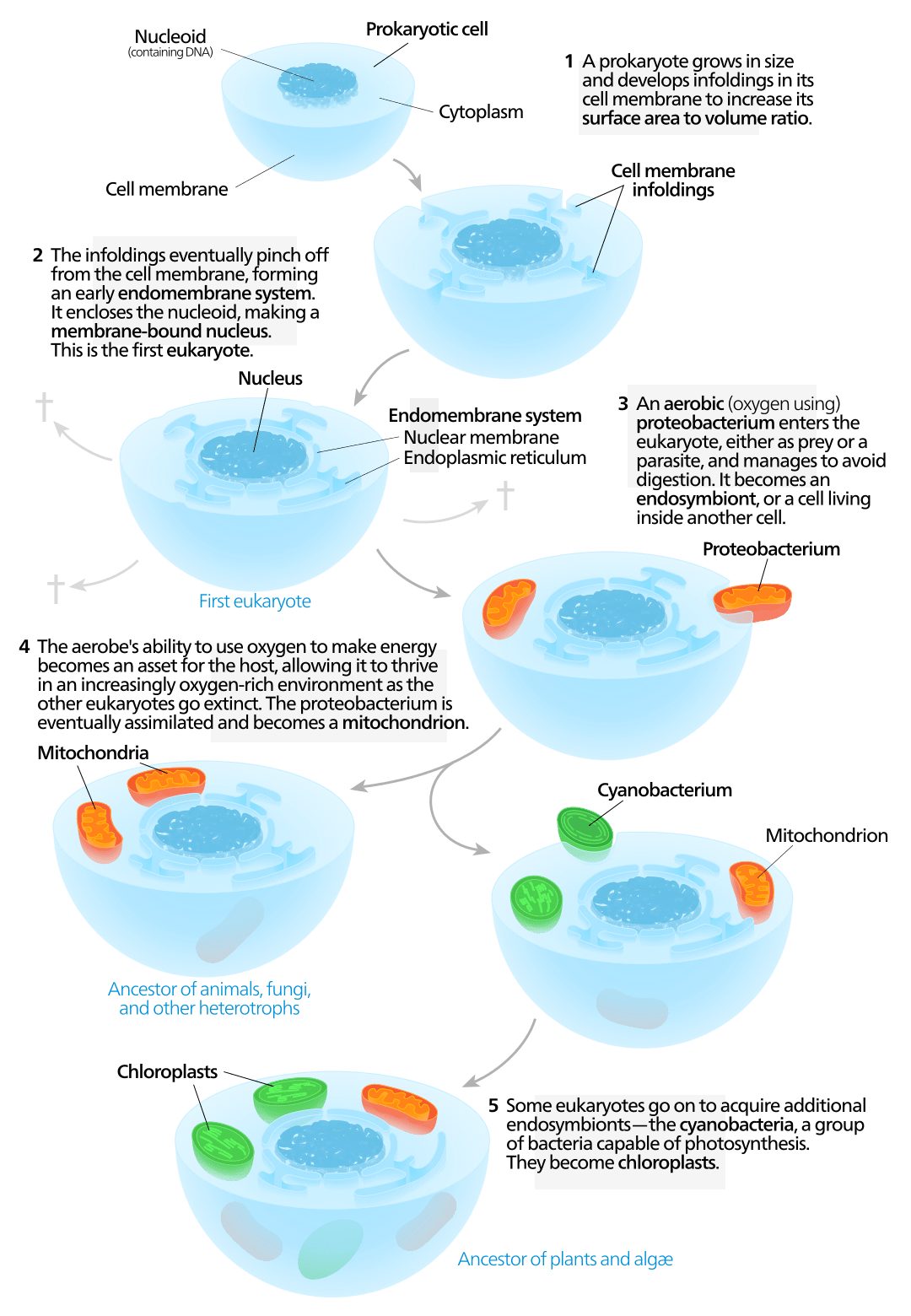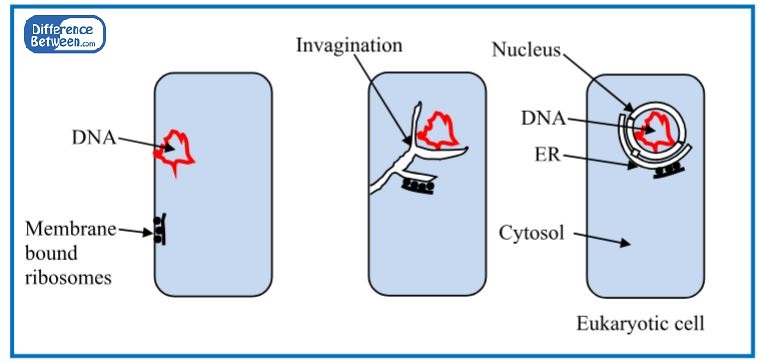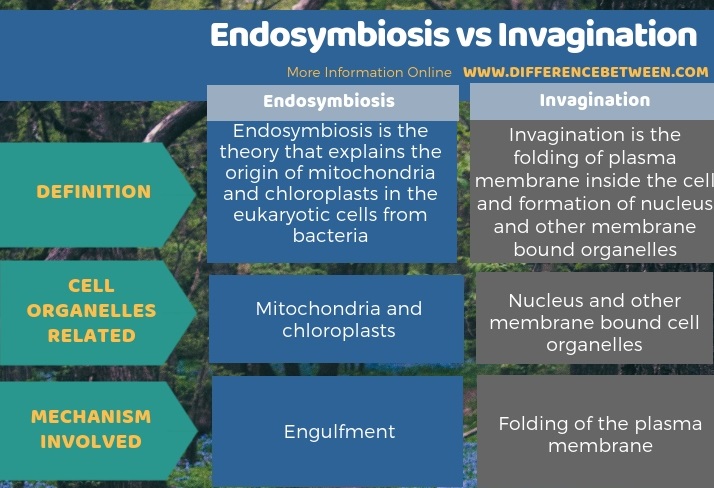Difference Between Endosymbiosis and Invagination
The key difference between endosymbiosis and invagination is that endosymbiosis is a theory that explains the origin of mitochondria and chloroplasts inside the eukaryotic cell while the invagination is a process that explains the origin of the nucleus and other cell organelles through the formation of invagination from the plasma membrane to the cell interior.
Scientists believe that eukaryotic cells have evolved from prokaryotic cells. They have developed many theories to explain how this evolution has occurred. Endosymbiosis is one such theory that explains the origin of mitochondria and chloroplast inside the eukaryotic cells from the prokaryotic bacteria. Whereas, invagination is a process that explains the origin of the nucleus and other membrane-bound organelles inside the eukaryotic cell.
CONTENTS
1. Overview and Key Difference
2. What is Endosymbiosis
3. What is Invagination
4. Similarities Between Endosymbiosis and Invagination
5. Side by Side Comparison – Endosymbiosis vs Invagination in Tabular Form
6. Summary
What is Endosymbiosis?
Endosymbiosis is a hypothesized process that explains the origin of the eukaryotic cell from a prokaryotic cell. It is one of the important events in evolution. Hence, it is an accepted theory in biology. Endosymbiosis theory describes how mitochondria and chloroplasts enter eukaryotic cells. These two organelles have their own DNA. Thus, it is believed that mitochondria have originated in eukaryotic cells from autotrophic alphaproteobacteria via endosymbiosis. This is a result of a symbiotic relationship between a primitive eukaryotic cell and an autotrophic bacterium. The primitive eukaryotic cell has engulfed the bacterium and eventually, their symbiotic relationship has lead to the origin of mitochondria in eukaryotic cells.

Figure 01: Endosymbiosis
On the other hand, chloroplasts have originated in plant cells from cyanobacteria through endosymbiosis. A primitive eukaryotic cell with mitochondria has engulfed a cyanobacterium and that has lead to the origin of chloroplasts inside the photosynthetic eukaryotic cells. Therefore, the endosymbiotic theory explains how mitochondria and chloroplasts are established inside the eukaryotic cells from bacteria.
What is Invagination?
Invagination is another process involved with the evolution of other organelles except for mitochondria and chloroplasts inside the eukaryotic cells. As explained in the above section, mitochondria and chloroplasts were engulfed by the primitive eukaryotic cell through the endosymbiosis. Hence, the origin of the nucleus and other organelles is believed to have happened by the invagination of the plasma membrane into the cell interior as a result of mutation. Due to this mutation, plasma membrane began to fold inside, forming an invagination. Eventually, this invagination grew over generations and surrounded the cell’s DNA by forming the nuclear envelope and the nucleus. Due to the less interference of cytoplasmic chemicals and reactions and other disturbances, DNA has started to evolve and change within the nucleus. That expanded the complex nature of the eukaryotic cell.

Figure 02: Invagination
Similarly, other cell organelles also began to form via invagination process. The membrane of the endoplasmic reticulum, Golgi apparatus, endosomes, and lysosomes are believed to have originated by invagination of the plasma membrane.
What are the Similarities Between Endosymbiosis and Invagination?
- Endosymbiosis and invagination are related to the evolution of eukaryotic cells.
- Also, both concepts explain the origin of different cell components of the eukaryotic cell.
What is the Difference Between Endosymbiosis and Invagination?
Endosymbiosis refers to the theory that describes the origin of mitochondria and chloroplasts inside the eukaryotic cells from prokaryotic cells. Invagination describes the origin of the nucleus and other membrane-bound organelles within the eukaryotic cells due to the folding of the plasma membrane inside. Therefore, this is the key difference between endosymbiosis and invagination. Endosymbiosis occurs via engulfment while invagination occurs via folding of the plasma membrane. So, this is also a significant difference between endosymbiosis and invagination.
Below infographic summarizes the difference between endosymbiosis and invagination.

Summary – Endosymbiosis vs Invagination
Endosymbiosis and invagination are two hypotheses in the evolution of eukaryotic cells. Endosymbiosis describes the engulfment of prokaryotic cells by eukaryotic cells and the origin of mitochondria and chloroplasts inside the eukaryotic cells. On the other hand, invagination is the folding of the plasma membrane in order to make the nucleus and other membrane-bound cell organelles inside the eukaryotic cell. Both theories help to understand how the eukaryotic cells developed and acquired complex nature over many generations. This is a summary of the difference between endosymbiosis and invagination.
Reference:
1. Endosymbiosis – The Appearance of the Eukaryotes, Available here.
2. Hesterman, Donna, and Nathan H Lents. “Cellular Organelles I | Biology.” Visionlearning, Visionlearning, Inc., 12 Feb. 2017, Available here.
Image Courtesy:
1. “Serial endosymbiosis” By Kelvinsong – Own work (CC BY-SA 3.0) via Commons Wikimedia
ncG1vNJzZmivp6x7pbXFn5yrnZ6YsqOx07CcnqZemLyue8OinZ%2Bdopq7pLGMm5ytr5Wau26xzZ2mrLGdl7awv8isZJqmlGK2r8LAoKCnmaSevK97